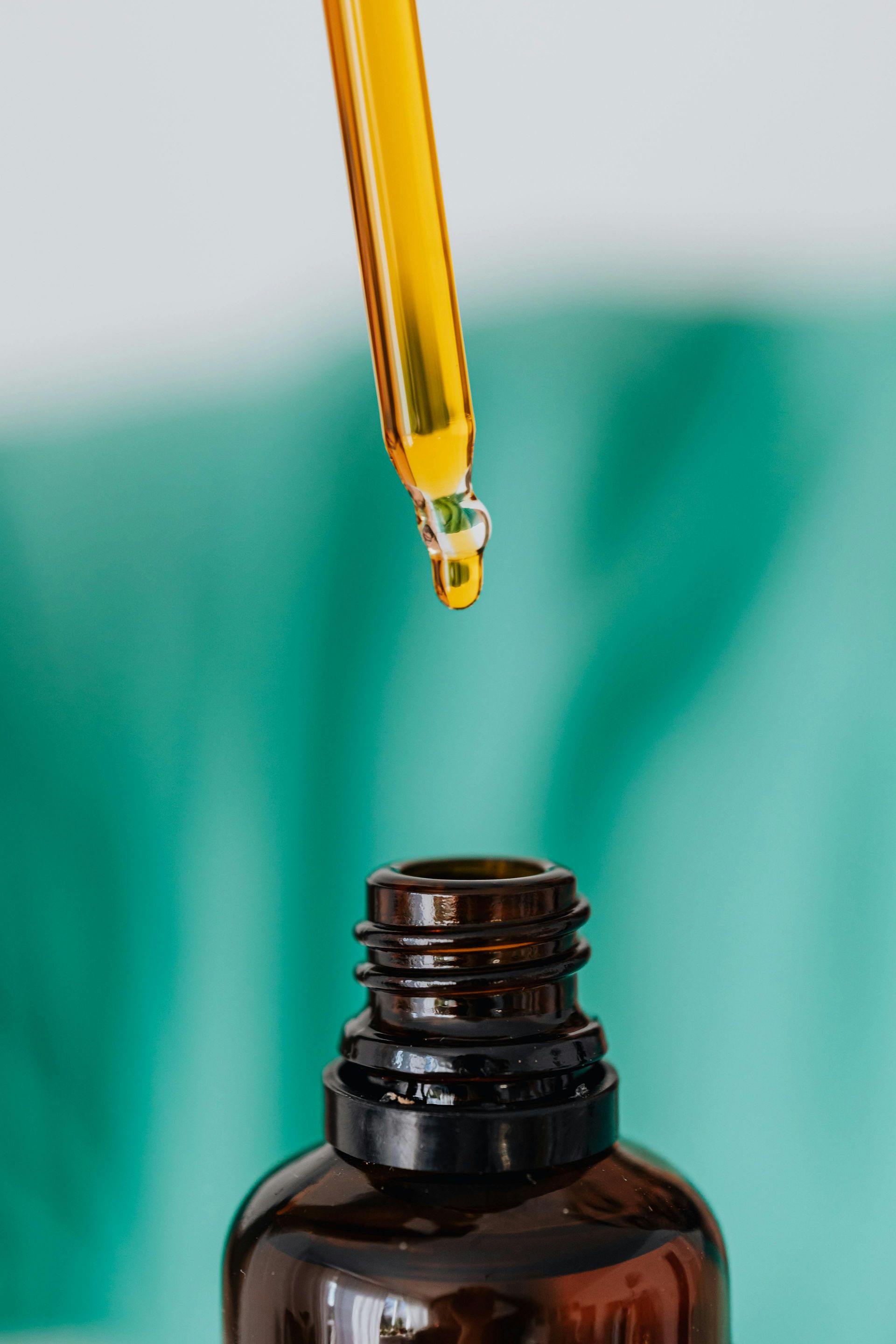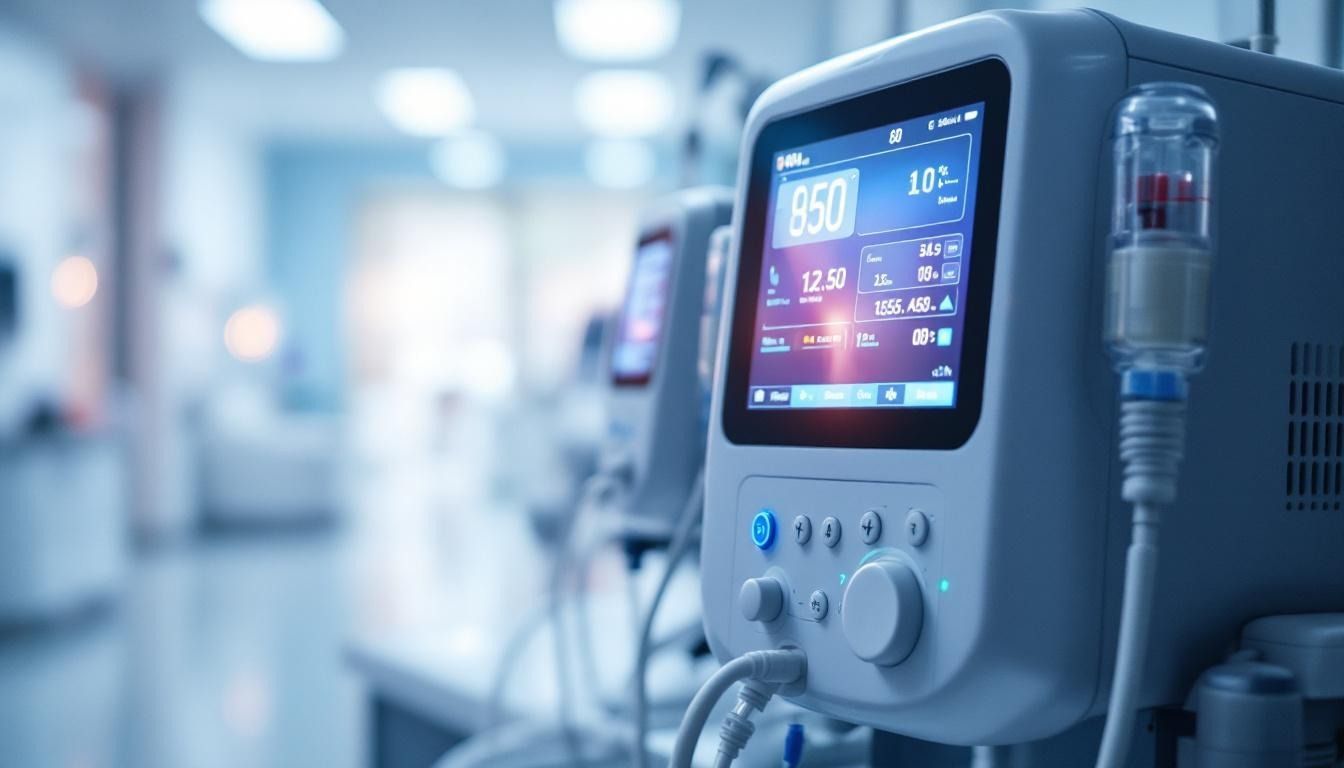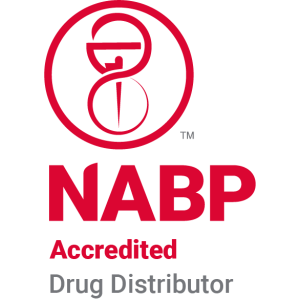The Role of Pharmacists in IPN Preparation and Monitoring
Understanding the Critical Role of Pharmacists in IPN
Pharmacists are integral to the safe and effective preparation and monitoring of intraperitoneal nutrition (IPN) and parenteral nutrition (PN). Their expertise spans the entire spectrum of nutrition support—from assessment and formulation design to clinical monitoring and quality assurance. This article explores the multifaceted roles pharmacists play, the standards guiding their practice, and the system-level strategies to optimize patient outcomes.
Pharmacists’ Core Roles in IPN and PN Therapy
Assessment of nutritional needs
Pharmacists play a central role in evaluating patients' nutritional requirements, especially when it comes to complex therapies such as parenteral nutrition (PN) and intraperitoneal nutrition (IPN). They assess individual patient conditions, including laboratory results and clinical indicators, to determine precise nutritional deficits and metabolic needs. This evaluation ensures that therapies are tailored appropriately, promoting optimal patient outcomes.
Design and compounding of nutrition formulas
One of the critical responsibilities of pharmacists is the design and sterile compounding of PN and IPN formulas. They create custom nutrition solutions for each patient, balancing protein, carbohydrates, fats, fluids, and electrolytes while minimizing risks such as infections or incompatibilities. Adherence to sterile compounding protocols and quality standards like USP 800 guarantees safety and efficacy in preparing these life-sustaining therapies.
Monitoring therapy response
Pharmacists are actively involved in monitoring patients during PN and IPN therapy to evaluate their response and detect potential complications early. They review laboratory results, such as albumin levels, BUN, electrolytes, and nutritional markers, alongside clinical signs, to adjust treatment as needed. Continuous monitoring helps prevent issues like metabolic disturbances, infections, or nutritional deficiencies.
Education of healthcare professionals and patients
A significant aspect of pharmacists' roles involves educating healthcare team members, patients, and caregivers. Pharmacists provide essential training on the proper handling, administration, and potential side effects of nutritional therapies. This educational support ensures that everyone involved understands the therapy, supporting adherence and safety.
Quality control and safety measures
Ensuring the quality and safety of PN and IPN formulations is paramount. Pharmacists implement strict quality assurance procedures, including sterile compounding practices aligned with regulatory standards. They perform regular reviews of medication profiles, monitor for contamination risks, and oversee storage and handling to uphold safety during the entire process.
What is the role of pharmacists in the preparation and monitoring of parenteral nutrition (PN) and intraperitoneal nutrition (IPN)?
Pharmacists have a significant role in ensuring the safe preparation and administration of PN and IPN, helping to optimize patient outcomes through precise nutritional management, adherence to best practices, and collaboration within multidisciplinary teams. They contribute to medication safety, quality assurance, and clinical monitoring during therapy.
How do pharmacists contribute to patient safety and medication management in PN and IPN therapy?
Pharmacists significantly contribute to patient safety and medication management in PN and IPN therapy by conducting thorough medication evaluations that consider individual patient factors, detecting and preventing adverse drug reactions, and ensuring appropriate therapy adjustments. They provide essential education to patients and caregivers on proper medication use, dosing, and potential interactions, enhancing adherence and reducing errors.
What are best practices and standards for pharmacists involved in PN and IPN preparation and monitoring?
Best practices and standards for pharmacists involved in PN (parenteral nutrition) and IPN (intraperitoneal nutrition) preparation and monitoring include adhering strictly to established protocols, sterile compounding standards, and quality control procedures to ensure patient safety. Pharmacists should stay updated with current guidelines and evidence-based practices to maintain high standards of care.
What is the role of pharmacists within interprofessional practice networks in supporting PN and IPN therapy?
Pharmacists play a vital role within interprofessional practice networks (IPNs) by providing expertise in medication management, ensuring the safe and effective use of nutrition therapies such as PN and IPN. They collaborate closely with healthcare teams to develop individualized nutrition plans, monitor patients' responses, and adjust therapies as needed to optimize outcomes.
How does pharmacist involvement impact clinical outcomes and patient care in PN and IPN therapy?
Pharmacist involvement in PN and IPN therapy enhances clinical outcomes and patient care by ensuring proper nutrition delivery, monitoring for adverse reactions, and reducing medication errors. They play a critical role in optimizing individualized treatment plans and providing expert guidance on nutritional and pharmacological interactions.
Standards and Guidelines in Pharmacist Practice for IPN and PN
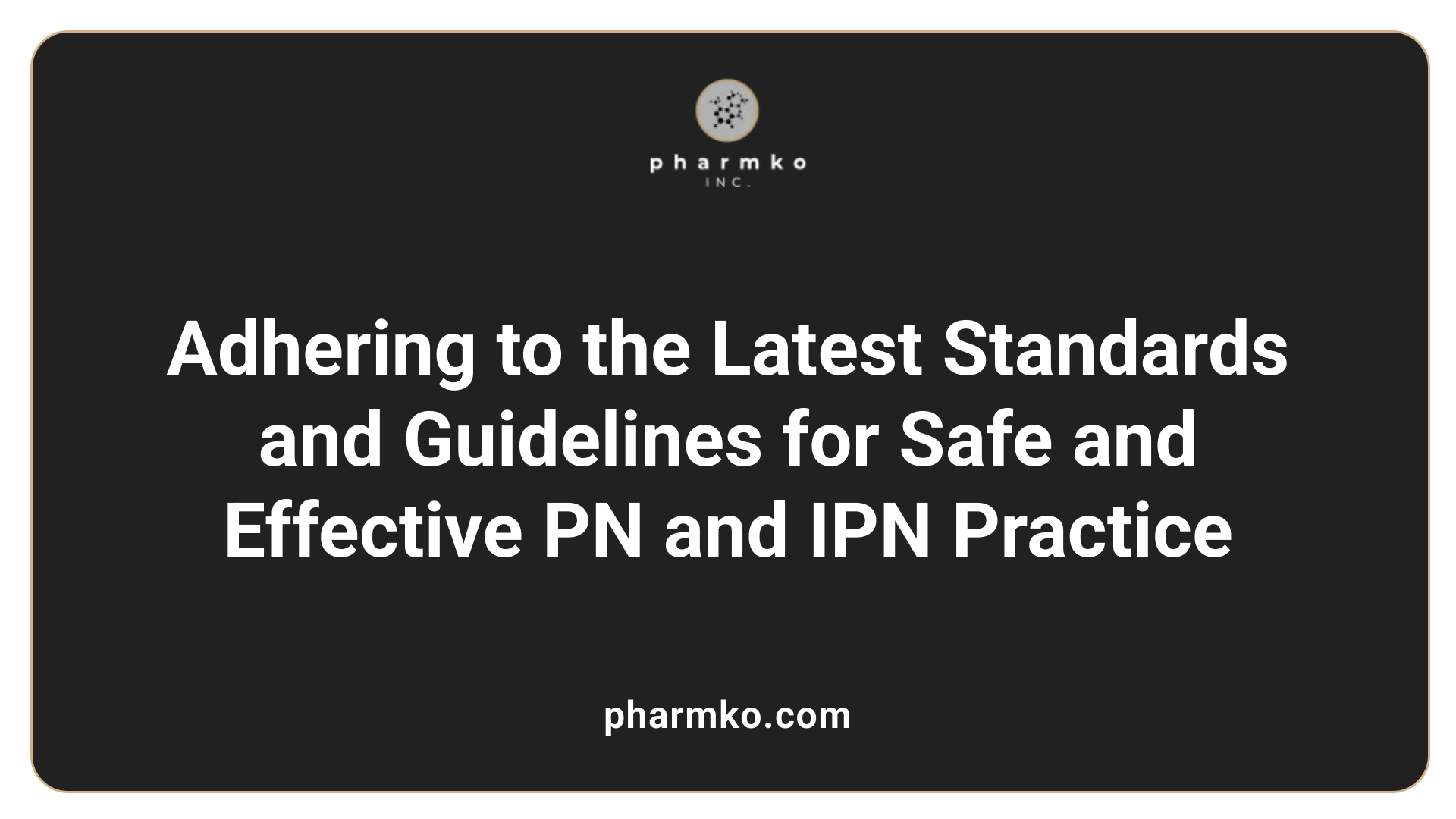
What are best practices and standards for pharmacists involved in PN and IPN preparation and monitoring?
Pharmacists play a vital role in preparing and monitoring parenteral nutrition (PN) and intraperitoneal nutrition (IPN) therapies. To ensure patient safety and treatment efficacy, they must adhere to established guidelines and protocols. This includes strict compliance with sterile compounding practices, rigorous quality control procedures, and ongoing education regarding current standards.
Implementing evidence-based practices is essential. Pharmacists should stay informed about the latest ASPEN (American Society for Parenteral and Enteral Nutrition) guidelines and ASHP (American Society of Health-System Pharmacists) standards, which outline optimal practices in nutrition support. Regular training and audits help maintain high compliance levels and reduce the risk of contamination or errors.
Customized formulations are compounded under sterile conditions, with meticulous checks throughout the process. Pharmacists verify formulations against prescriptions to ensure accuracy, appropriate nutrient composition, and compatibility. Continuous monitoring of patient response, laboratory values, and potential complications allows timely adjustments, minimizing adverse outcomes.
What system-level safety practices can optimize pharmacy involvement in PN and IPN preparation?
At a system level, organizations should adopt comprehensive safety practices to foster a secure environment for PN and IPN therapy. Establishing standardized protocols based on current guidelines is crucial for consistency across the board.
Implementing rigorous staff training programs ensures that pharmacy personnel are well-versed in aseptic techniques, quality assurance measures, and troubleshooting procedures. Regular competency assessments and updates help sustain high standards.
Technology also plays a pivotal role. Utilization of electronic systems for verification, tracking, and documentation enhances accuracy and accountability. Automation and barcode technology can reduce human error during compounding and dispensing.
Additionally, fostering a multidisciplinary approach involving pharmacists, physicians, nurses, and quality assurance teams improves communication and coordination. Systematic audits and ongoing quality improvement initiatives further optimize safety and effectiveness of PN and IPN preparations.
| Aspect | Focus Area | Implementation Details |
|---|---|---|
| Standards | Compliance | Adhering to ASPEN/ASHP guidelines; regular staff education |
| Sterile Procedures | Compounding | Use of laminar airflow hoods, PPE, and aseptic techniques |
| Documentation | Verification | Electronic records, double checks, and batch tracking |
| Technology | Safety Tools | Barcode verification, automated dispensing systems |
By integrating these practices, healthcare organizations can ensure safe, effective, and high-quality nutrition support therapies for patients in diverse clinical settings.
The Pharmacist’s Role in Education and Training
What educational and training considerations are important for pharmacists involved in PN and IPN preparation and monitoring?
Pharmacists engaged in parenteral nutrition (PN) and intraperitoneal nutrition (IPN) preparation and oversight must undergo comprehensive education that extends beyond traditional pharmacy training. Specialized coursework in sterile compounding is essential to ensure the safe preparation of nutrition formulations, adhering to strict sterilization protocols and quality control procedures.
In addition to technical skills, knowledge of nutrition therapy is crucial. Pharmacists should be familiar with the specific formulations used in PN and IPN, understanding how to customize these based on individual patient needs. This includes proficiency in compounding techniques that maintain stability and compatibility of nutrients, as well as the ability to identify and manage adverse events related to nutrition therapy.
A vital part of modern pharmacy practice involves understanding data privacy and legal considerations. Pharmacists must be aware of data protection laws such as GDPR in Europe and CCPA in California, especially when handling inferred or derived data from patient monitoring systems. Ensuring patient confidentiality and compliance with legal standards is fundamental when utilizing electronic health records and sensor-derived information.
The increasing use of data analytics in healthcare also calls for familiarity with advanced analytical methods like machine learning and data modeling. These tools help assess therapy outcomes, detect early signs of adverse reactions, and optimize nutritional interventions.
Moreover, continuous education is vital to stay updated on the evolving legal regulations and technological advancements. Pharmacists should engage in ongoing professional development through seminars, certifications, and participation in specialized training programs. Skills in evaluating the accuracy and potential biases of predictive models are important to ensure reliable monitoring of PN and IPN therapy.
These educational components collectively empower pharmacists to provide safer, more effective nutritional care, leverage innovative analytical tools responsibly, and adhere to legal standards, ultimately improving patient outcomes in complex nutrition support scenarios.
Challenges and Opportunities in PN and IPN Pharmacist Care

What challenges do pharmacists face in delivering pharmaceutical care related to PN and IPN, and what opportunities exist to improve care?
Pharmacists are vital members of the nutrition support team, especially in managing parenteral nutrition (PN) and intraperitoneal nutrition (IPN) therapies. However, their involvement comes with specific challenges that can affect patient safety and therapy effectiveness.
One major hurdle is the complexity involved in nutrient compounding. PN and IPN formulations require precise mixing of multiple nutrients, including amino acids, dextrose, electrolytes, and vitamins, often in sterile conditions. Maintaining sterility throughout the compounding process is crucial to prevent infections but can be technically demanding, demanding rigorous quality control measures.
Another significant challenge is staying up-to-date with the latest nutrition protocols and guidelines. As research advances, protocols evolve, and pharmacists need continuous education to adapt their practices accordingly. This ongoing learning process is essential to ensure that patients receive the most effective and current nutritional therapies.
Effective communication within healthcare teams remains a commonly cited barrier. Collaboration among pharmacists, physicians, dietitians, and nursing staff is imperative for coordinated patient care. Miscommunication or lack of clarity can compromise therapy safety and lead to complications or suboptimal outcomes.
Monitoring patients on PN and IPN therapies involves interpreting various laboratory results, such as albumin, BUN, and electrolyte levels, as well as clinical assessments. Accurate interpretation and timely adjustments are vital to prevent issues like electrolyte imbalances, infections, or metabolic disturbances.
Despite these challenges, numerous opportunities exist to enhance pharmaceutical care in PN and IPN management. Continuing education and specialized certifications, such as the Board Certified Nutrition Support Pharmacist (BCNSP), can build pharmacists’ expertise.
Implementing integrated electronic health records (EHRs) can streamline communication, enable real-time monitoring, and reduce errors in formulation and administration. Strengthening interdisciplinary collaboration through standardized protocols and regular team meetings can also improve care consistency.
Moreover, developing and adopting advanced training programs focused on sterile compounding, nutritional pharmacology, and clinical monitoring can better prepare pharmacists. Such initiatives can help them contribute more effectively to clinical decision-making, patient safety, and outcomes.
In summary, while pharmacists face notable obstacles in delivering specialized PN and IPN care, these challenges present opportunities for system improvements, education, and teamwork. Investing in these areas can lead to safer, more effective nutritional therapies and better patient health.
Impact of Pharmacist Involvement on Clinical Outcomes
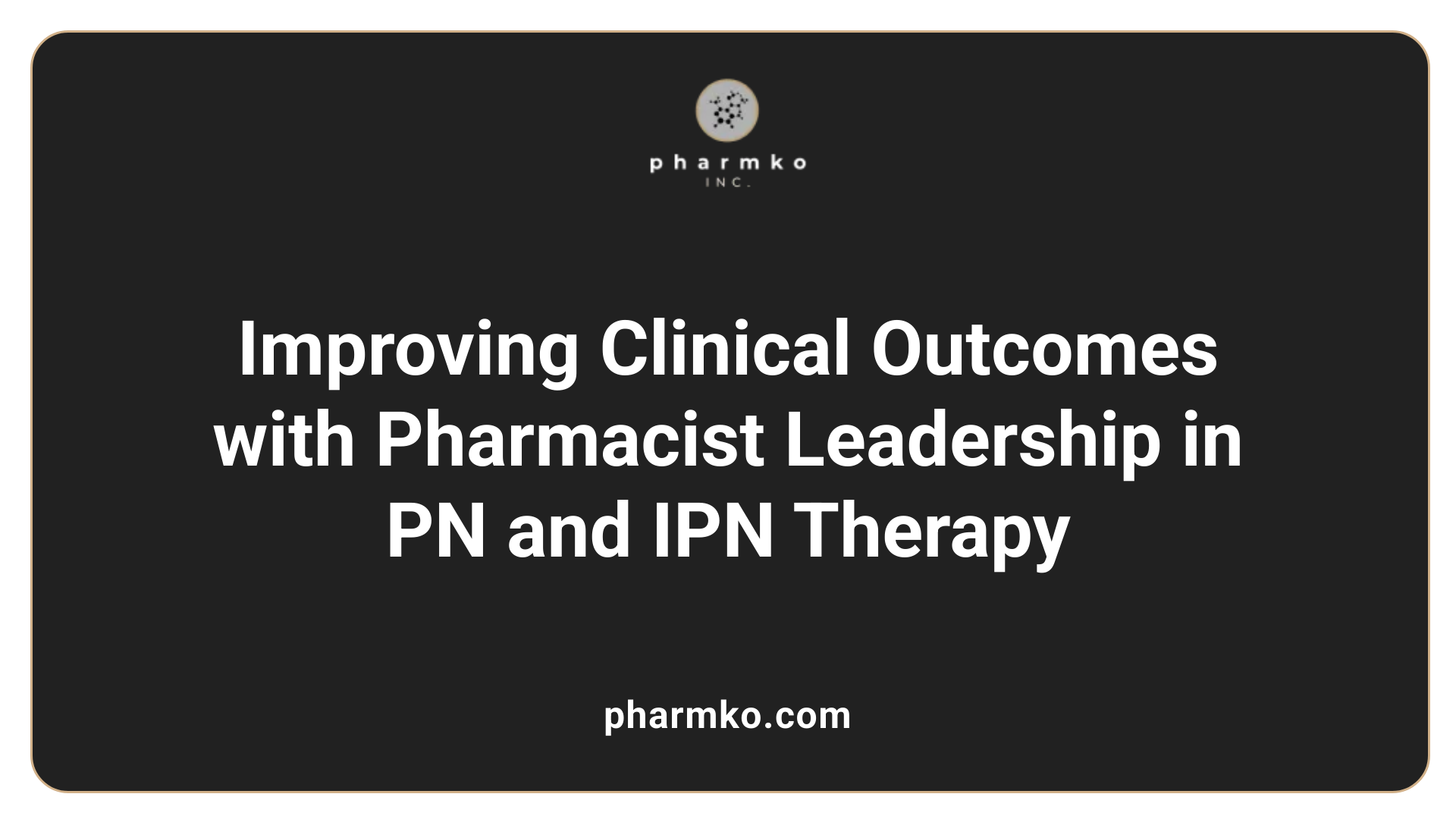
How does pharmacist involvement impact clinical outcomes and patient care in PN and IPN therapy?
Pharmacists play an indispensable role in the management of parenteral nutrition (PN) and related therapies like Intradialytic Parenteral Nutrition (IDPN) and Intraperitoneal Nutrition (IPN). Their expertise directly influences patient health, safety, and recovery.
In PN therapy, pharmacists are involved in assessing patients' nutritional needs, designing personalized formulations, and ensuring the safety and quality of compounded solutions. They supervise the preparation process to meet strict safety standards and monitor patients’ responses through laboratory and clinical evaluations.
By actively participating in patient monitoring, pharmacists help detect early signs of complications such as electrolyte imbalances, infections, or metabolic disturbances. This early detection allows for prompt adjustments in therapy, minimizing risks.
Pharmacists also tailor nutrition therapy to individual patient requirements, considering underlying health conditions and treatment responses. They adjust formulations as needed, enhancing the effectiveness of nutritional support.
The collective efforts of pharmacists lead to a significant reduction in medication errors, as they review medication profiles and oversee compounding procedures. This reduction directly correlates with improved safety and fewer adverse events.
Furthermore, pharmacist involvement contributes to higher recovery rates by optimizing nutritional intake, preventing deficiencies, and managing therapy-related complications efficiently. Their role extends into education for patients and healthcare providers, fostering better adherence and understanding.
Overall, multidisciplinary collaboration, supported by guidelines from organizations such as ASPEN and ASHP, underscores the positive impact pharmacists have on clinical outcomes, especially in complex nutritional therapies like PN and IPN.
System-Level Interventions to Improve Safety in Nutrition Support
What system-level safety practices can optimize pharmacy involvement in PN and IPN preparation?
Enhancing the safety of parenteral nutrition (PN) and injectable nutrient (IPN) preparations requires organization-wide strategies rooted in best practices. One of the most effective approaches is establishing standardized protocols that outline step-by-step procedures for compounding and quality control. These protocols must align with recognized safety standards such as USP 800 to ensure a uniform safety baseline.
Complementing these protocols, comprehensive staff training programs are essential. Regular education sessions, competency assessments, and updates on the latest safety standards help keep pharmacy staff informed and proficient. Well-trained personnel are better equipped to recognize and mitigate risks during PN and IPN preparation.
The integration of electronic safety systems further strengthens safety measures. Automated medication safety checks, barcode verification, and computerized dispensing systems reduce human error risks, improve accuracy, and streamline workflow processes.
Interprofessional collaboration plays a critical role as well. Pharmacists working closely with nurses, physicians, and other healthcare professionals foster real-time communication about patient needs, potential contraindications, and safety concerns. This teamwork ensures that safety is maintained across all stages of nutrition support, from assessment to administration.
Continuous quality improvement activities are vital for sustaining progress. Regular audits, incident reporting, and benchmarking against accreditation standards or industry guidelines help identify areas for enhancement. Engaging in these activities encourages a culture of safety and accountability.
In sum, implementing evidence-based, system-wide safety practices — including standardized protocols, staff training, automation, and teamwork — optimizes pharmacy involvement in PN and IPN, minimizing risks and promoting the best possible patient outcomes.
Contributions of Pharmacists within Interprofessional Practice Networks

What is the role of pharmacists within interprofessional practice networks in supporting PN and IPN therapy?
Pharmacists are integral members of interprofessional practice networks (IPNs) when it comes to parenteral nutrition (PN) and integrated nutrition support therapies like IPN. They bring specialized knowledge in medication management, which is essential for ensuring the safety, efficacy, and quality of nutritional therapies. Their collaboration with healthcare teams enables the development of personalized nutrition plans tailored to each patient’s unique needs.
In these networks, pharmacists assess patients' nutritional requirements closely, considering laboratory results and clinical status. They participate with physicians, dietitians, nurses, and other healthcare providers to design and refine nutrition strategies. This teamwork is crucial for addressing complex patient needs, especially in critical or outpatient settings.
Furthermore, pharmacists monitor patient responses to therapies, reviewing biochemical markers such as albumin, BUN, electrolyte levels, and other lab values. They make necessary adjustments to formulations like PN, IDPN, and IPN, to optimize nutrition delivery and minimize risks like electrolyte imbalances or infections.
Beyond direct patient care, pharmacists contribute significantly to medication reconciliation and safety. They identify potential drug-nutrient interactions that could impact therapy effectiveness or patient safety, role that becomes especially critical in patients with multiple co-morbidities or those on complex medication regimens.
Education forms another pillar of their contribution. Pharmacists train healthcare staff on proper administration techniques and safety protocols related to PN and IPN therapies. They also provide essential counseling to patients and caregivers, helping them understand therapy goals, manage side effects, and recognize early signs of complications.
This multi-faceted involvement of pharmacists in IPNs enhances coordination across disciplines, reduces the incidence of adverse events, and supports a patient-centered approach. It exemplifies how shared expertise leads to improved clinical outcomes, reduced healthcare costs, and a more comprehensive management of nutrition support programs.
Best Practices to Ensure Safe Preparation and Monitoring of PN and IPN
What are best practices and standards for pharmacists involved in PN and IPN preparation and monitoring?
Pharmacists play an essential role in preparing and monitoring parenteral nutrition (PN) and intraperitoneal nutrition (IPN) therapies. To ensure patient safety and optimal outcomes, they must adhere to rigorous standards and protocols.
Firstly, compliance with sterile compounding standards is crucial. This involves following guidelines such as USP <797> and USP <800>, which set criteria for sterile preparation, contamination prevention, and personnel practices. Pharmacists must employ aseptic techniques during preparation to minimize infection risk.
In addition, quality control measures are vital. These include verifying the accuracy of components, ensuring proper labeling, and conducting routine checks on the integrity and stability of the formulations. Routine Laboratory and clinical monitoring of patients further aids in early detection of potential adverse reactions or complications.
Staying current with evidence-based practices and guidelines from reputable organizations like ASPEN and ASHP ensures high-quality care. Regular training and participation in professional development programs help pharmacists maintain competency.
Documentation plays a critical role. Meticulous recording of preparation procedures, component lot numbers, timestamps, and quality checks not only promotes safety but also supports traceability and accountability.
Monitoring therapy response through clinical assessment and laboratory values such as albumin, prealbumin, and inflammatory markers allows pharmacists to make necessary adjustments quickly.
Moreover, employing automation such as computerized order entry systems and infusion pumps can reduce errors. These systems often include checks for compatibility, dosing accuracy, and indication-related appropriateness.
Consistent review and verification processes, combined with collaborating closely with the multidisciplinary team—including physicians, dietitians, and nurses—are essential. This teamwork ensures comprehensive oversight and swift handling of any issues encountered during therapy.
Lastly, ongoing education and quality improvement initiatives are fundamental. They involve reviewing procedures, analyzing adverse events, and implementing improvements in processes.
These practices not only align with established standards but also foster a culture of safety, precision, and continuous improvement in nutrition therapy management.
| Aspect | Best Practice Examples | Purpose |
|---|---|---|
| Safety Standards | Adhere to USP <797>/<800>, strict aseptic technique | Prevent contamination and infections |
| Documentation | Detailed logs of preparation, verification, and monitoring | Ensure traceability and accountability |
| Use of Automated Systems | Computerized ordering and infusion pumps | Minimize human error and improve accuracy |
| Education & Collaboration | Regular team training, multidisciplinary review meetings | Promote informed decisions and oversight |
| Continuous Monitoring | Frequent clinical and laboratory assessments | Detect issues early and adjust treatment promptly |
By integrating these practices, pharmacists uphold the highest safety and quality standards in PN and IPN preparation and management, ultimately safeguarding patient health and improving treatment efficacy.
Pharmacists' Expanding Role in Clinical Research and Public Health
How do pharmacists manage clinical trials and investigational products?
Pharmacists are integral to the conduct and management of clinical trials. They handle the procurement, storage, and dispensing of investigational products, ensuring compliance with regulatory standards such as USP 800. Pharmacists review medication profiles, oversee sterile compounding, and maintain strict accountability for drug supply. This careful management prevents contamination and ensures patient safety.
In addition, pharmacists assist in assessing trial feasibility, provide educational support to the research team, and monitor for adverse effects during trials. They help evaluate the efficacy and safety of new treatments, contributing valuable insights that shape therapeutic advancements.
What is the role of pharmacists in the supply chain and storage of investigational products?
Pharmacists coordinate tightly controlled supply chains for investigational products to prevent errors and ensure optimal drug integrity. They manage ordering, receiving, storage conditions, and documentation, adhering to strict safety protocols.
Their expertise guarantees that drugs are stored under proper conditions—temperature, humidity, and cleanliness—preserving efficacy and safety. They also oversee the proper disposal of unused or expired medications, aligning with environmental and safety regulations.
How do pharmacists contribute to the advancement of new therapies?
Pharmacists play a pivotal role in bringing new treatments from bench to bedside. They participate in the development phases by providing clinical insights, evaluating evidence, and assisting in protocol design.
During clinical trials, pharmacists ensure correct medication dosing, monitor patient responses, and document outcomes. Their involvement accelerates the development process by identifying issues early and refining therapeutic strategies, ultimately facilitating faster approval and dissemination of innovative therapies.
How do pharmacists support public health initiatives?
Pharmacists engage at both micro and macro levels within public health. They educate communities about disease prevention, promote vaccination programs, and conduct health screenings.
In emergency preparedness, pharmacists are vital in vaccine distribution efforts, managing stockpiles, and training health personnel. They also serve as advocates for health policy reform, providing data and expert opinions to influence legislation that improves access and safety.
Pharmacists' broad involvement—from managing clinical research to advancing public health—underscores their vital role in healthcare innovation, safety, and community well-being.
| Role | Responsibilities | Impact |
|---|---|---|
| Clinical research management | Procurement, storage, dispensing of investigational drugs | Ensures safety, compliance, and efficacy |
| Supply chain management | Inventory control, temperature regulation, disposal | Maintains drug integrity and environmental safety |
| Therapy development | Protocol design, dosing, monitoring outcomes | Accelerates new treatment availability |
| Public health support | Vaccination, education, health screenings | Improved health literacy and disease prevention |
This integrated approach highlights how pharmacists extend beyond traditional roles, fostering innovation, safety, and improved health outcomes.
Enhancing Patient Outcomes Through Pharmacist Expertise
Pharmacists’ comprehensive involvement in IPN and PN therapies—from formulation to clinical monitoring—serves as a cornerstone for achieving optimal patient safety, reducing complications, and improving health outcomes. Embracing advanced training, adhering to best practices, participating in interprofessional teams, and implementing system-level improvements are essential strategies to harness the full potential of pharmacists in supporting complex nutritional therapies. Their evolving roles exemplify a commitment to excellence in healthcare, ultimately benefiting patients worldwide.
References
- Role of pharmacists in providing parenteral nutrition support
- Renal Nutrition IDPN/IPN
- The Role of Pharmacists in Clinical Research
- The Role of the Pharmacist in Public Health
- ASHP Statement on the Role of Pharmacists in Primary Care
- Pharmacist's Role in Medication Safety | PSNet - AHRQ
- Medication Dispensing Errors and Prevention - StatPearls
- Medication Safety Checklist for Pharmacists: Know Your Role



